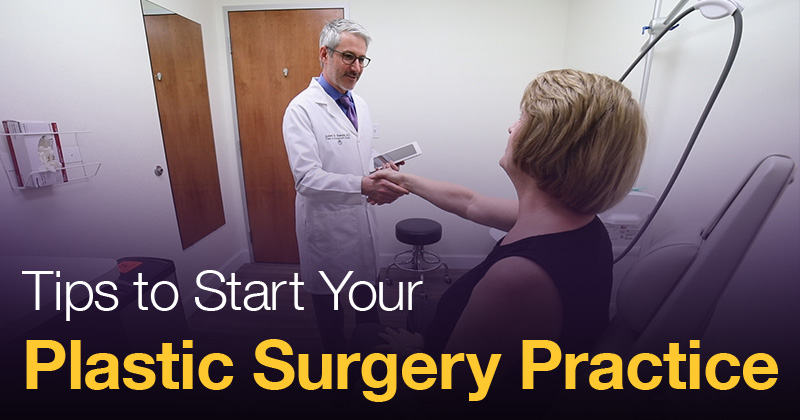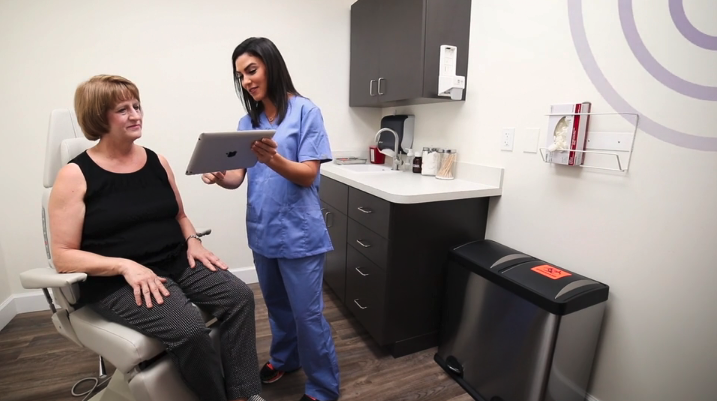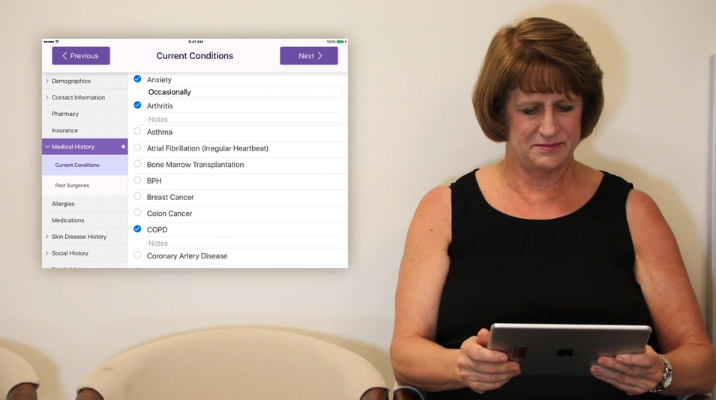Starting a Plastic Surgery Practice?

Five tips to consider, including how the right plastic surgery software should be part of your plan.
You’re in the final year of residency or fellowship, so naturally you’re beginning to wonder, what’s next? Should you join an established plastic surgery practice? Start your own? Work for a multi-specialty group? Go into academia? Further training? With the varied options that exist, you’ll need to evaluate your goals and your personal mission.
With all these options, unknown variables exist, but have no fear. You certainly won’t be the first nor the last plastic surgeon to embark on this journey. But you should learn from our successes and missteps rather than recreate the wheel.
As a private practice plastic surgeon for 15 years and having worked in virtually all of the settings mentioned above, I’ve been fortunate enough to successfully experience two different career paths which can help you. In my plastic surgery practice, I can fully engage my passion for reconstructive and cosmetic surgery and treat patients. I also serve as the medical director of plastic surgery for a major forward-thinking health IT company. I get the best of both worlds and want to share them with you.
In this post, I’ll outline some considerations that I believe are key should you decide to start your own plastic surgery practice.
1. Create your (realistic) vision and plastic surgery business plan including financial needs.
Time and patience are key. You need to take a calculated risk when deciding to start your own plastic surgery practice. Mapping out a realistic timeline, planning for expenses and deciding on marketing efforts will all come into play during this process.
You’ll want to start the process by drafting an executive summary which will be the framework for your plastic surgery business plan.
While the list below just covers the basics, the elements for this may include:
- The business opportunity: With the rapid growth of the aesthetic industry and trends, there will be no shortage of patients needing treatments. But how you will you differentiate your practice from others?
- Advantages of the opportunity: Can your plastic surgery practice cater to a niche market in the area for certain procedures not as commonly offered?
- Your target market: What is the demographic makeup of the area? Will this help determine the size of your practice? Will it dictate the cosmetic surgery offerings you will provide for patients?
- Products and services offered for your identified target market: Will you focus on mainly cosmetic or reconstructive procedures? Will this change over time? Will you offer medical spa services too?
- Strategic plastic surgery marketing and sales initiatives: How will you build your brand awareness and patient base in your community?
- The competitive landscape: How many other plastic surgery practices are in the area? What about other surgeons, nonsurgeons, or medspas offer similar services?
- Summarized financial plan: What are your estimated startup and ongoing costs? How much capital will you need to start your plastic surgery business?
- Owners and key staff members: How many individuals will you bring onboard? What are their credentials and job roles?
- Implementation plan: What is the timeline for opening your practice? What are the key performance indicators (KPIs) to measure success and timeframe to achieve them?
These are just some of the questions you will want to clearly answer along with the data, as needed, to back your plastic surgery business plan up.
As for an anticipated timeline of when to start the process on certain tasks, noted below are just some of the key items you may consider, and to plan accordingly for each.
- Begin process of licensing and regulations 3 – 4 months in advance to avoid any last minute surprises. For example, in Florida medical licenses can take a year to obtain.
- Start insurance credentialing 9 – 12 months in advance, so you can bill starting on day one. The importance of this may vary depending on the business you anticipate from more elective surgeries or one from medical necessity.
- Choose your practice location 6 months ahead of time – you’ll need a physical address to process forms. You also want to evaluate where there may be a need in the market as well as evaluate costs for purchasing or renting and any construction or build outs.
- Hire your staff about 6 weeks before opening day to get everyone ready for your first patient.
Now for the money talk. How are you going to fund the capital needed to get your plastic surgery practice up and running? There are certainly various options out there. Whichever you choose, prepare to have at least two years worth of funds available and expect to skip a personal salary for some time. Financial stability will be critical to long-term success. Outlined below are some of the funding options to consider.
- Self-funding
- Friends and family
- Loan from a small or larger bank
- Investors
- A partner
As for marketing, that also takes a fair amount of funds to run well. I’ll expand on the plastic surgery marketing ideas a bit later in this post.
You probably had a plan mapped out before you decided to go through years of schooling to become a plastic surgeon in the first place. You should exert the same effort, if not more, into your business to reap long-term benefits. A relatively short term investment in the planning stages may pay off down the road.
2. Hire the right staff and start small.
You want to keep expenses at bay when you’re still growing your patient base. Remember, you have probably already spent a fair amount of money before bringing any funds in. You may want to hire only the essential staff at first. You need to build your brand and your referral base which will take time so you can increase patient volume. Prepare yourself, as it could take five years to be at full capacity.
Once you get started, don’t feel pressured to build out every exam room in your office. You do want the physical space to grow, but equipping each room is an expensive proposition and one that you don’t want to incur until your practice is running at full capacity.
Start with the must-haves not just the nice-to-haves to get your plastic surgery up and running. It comes down to supply and demand.
3. Consider equipment needed and leasing certain devices.
Again everything in moderation. While you may want to purchase the latest and greatest lasers and devices, it may make sense to lease equipment that you expect to generate the most interest from potential patients. Your geographic location and patient populations served may help indicate which treatment offerings would be the most sought after and needed in the community. For example, IPL is very common but a great starting point, a proven tool, not very expensive, and can be used to treat multiple conditions.
It’s crucial to stay abreast of plastic surgery and aesthetic industry trends as well. The American Society of Plastic Surgery (ASPS) issues press releases and reports on market trends based on data. Maybe laser resurfacing will be an area of focus, perhaps it’s injectables, or maybe it’s mainly reconstructive plastic surgery offerings. Staying in tune to both trends in your local patient population as well as the industry can help lead to better decisions for your business and your patients, too.
4. Craft a plastic surgery marketing strategy.
Marketing takes both time and money to do well, which are certainly two valuable resources. Based on your geographic location you’ll have to ask yourself, would a billboard reach your potential patients? Maybe it’s an advertorial in the area’s high-end lifestyle magazine? Or perhaps it’s an ad in the local newspaper? What about social media marketing? It’s probably a strategic combination of those marketing tactics.
With so many viable avenues to help market your new plastic surgery business, it makes sense to focus on which ones have the best return on investment. This will take some time to fine tune and you may need to hire a plastic surgery marketing agency to help jumpstart these initiatives for you.
So what are some avenues you should investigate when marketing your new plastic surgery practice? Keep the goals in mind. For your new plastic surgery practice this will be to gain brand awareness in your community and attract patients.
- Your website. Focus on creating a robust plastic surgery website that is built out with relevant content. This includes your bio, aesthetic and reconstructive offerings, address, contact info, etc. prior to launching your practice. The more information the better. At first, you may not have the bandwidth to commit to regularly updating a plastic surgery blog on your site, but keep it in mind for your ongoing marketing strategy. A plastic surgery blog is a great way to inform prospective patients on your offerings, create thought leadership, and help your website and your practice appear in Google searches from prospective patients.
- Accurate location information. Secure your business listings on sites such as Google, Yahoo, Yelp, Facebook, etc. You want to be accessible for current and future patients. Phone numbers, your address, email and photos all can help direct a potential plastic surgery patient your way. Also make sure review websites have accurate information and that you track your reviews and encourage happy patients to review you!
- An engaging and consistent social media presence. Pick and choose the right platform for you. Instagram is all about images and offers a medium where you can display both photos and videos. As plastic surgery is a very visual field, this social media platform can lend itself well for your business. Be careful not to underestimate the time it takes to maintain content across every social media platform that exists. It may be more important to focus one on medium consistently than spreading yourself too thin, attempting to have a presence across all platforms. That will do more harm than good. A profile page that lacks consistent updates can send a negative message to a potential patient considering your practice. Your social media profiles should reflect your brand and your vision for your practice.
- Traditional print advertising. Despite what some may claim, print media is not dead, and it’s a great way to build awareness and relationships in the local community. Advertising in a high-end glossy magazine or taking out an ad in the local, but well-read newspaper may still serve a valuable purpose.
- Public relations. Have the right combination of public relations in your marketing toolkit for added practice publicity. This can include everything from distributing a press release about your new practice to the local media, landing both local and industry speaking opportunities, sponsoring the local youth sports league or donating a gift basket to a nonprofit. Look for opportunities to become a thought leader in the local community, as well as the larger plastic surgery industry.
According to the rule of seven, you’ll find that plastic surgery marketing is an ongoing process, and your patients have to see and recognize the item or service multiple times over (usually seven, hence the name) before they take action. Word-of-mouth is invaluable and as you build up your patient-base, this will in turn grow your practice, making patient advocates critical to your success.
5. Opt for the best plastic surgery software to fit your workflow.
 Just like there were options for when you made the decision to embark on your own plastic surgery practice journey, there are options when it comes to plastic surgery software, including your electronic health records (EHR) system of choice.
Just like there were options for when you made the decision to embark on your own plastic surgery practice journey, there are options when it comes to plastic surgery software, including your electronic health records (EHR) system of choice.
You’ll spend quite a bit of time in your practice and with your plastic surgery software, so you want to make sure you select the option best suited for your needs, your staff and your patients. Evaluate different options on the market, speak to current users of those systems, take a look at review websites like Software Advice, and meet members of the vendor’s team to see an in-person demo at an upcoming plastic surgery event. Much like you made a business plan for your practice, you should make a plan for evaluating plastic surgery EHR systems. Create a list of the features, requirements and questions you have before embarking on your plastic surgery software evaluation process.
You will want to consider all aspects of your practice, from the patient experience, to your staff and your experience to meet your desired workflow. The more intuitive the plastic surgery EHR system is to use, the better the experience will be for everyone. And better experiences can lead to better results.
In addition to a plastic surgery EHR offering, consider the other tools you may need to run your business such as a practice management system, billing operations, analytics tools and patient engagement tools such as kiosk, portal, automated appointment reminders and surveys. Seek out a vendor that offers an all-in-one, integrated plastic surgery software solution. You’ll also want to think about accessibility to patient records as you switch between your practice, other offices and hospitals. Having a cloud-based EHR system that integrates with your practice management software may be critical to your mobility and patient care. It can save a whole lot of headaches and not to mention valuable time in the long run.
Conclusion
Starting a business comes with risks, but the rewards can be far greater. Having a solid plastic surgery business plan in place will help set the foundation for long-term success. Patience, persistent and sound business decisions like selecting the right location, a mix of aesthetic and reconstructive offerings, staff, marketing and technology are all determining factors that may help put your plastic surgery practice in the best possible position for long-term success.
